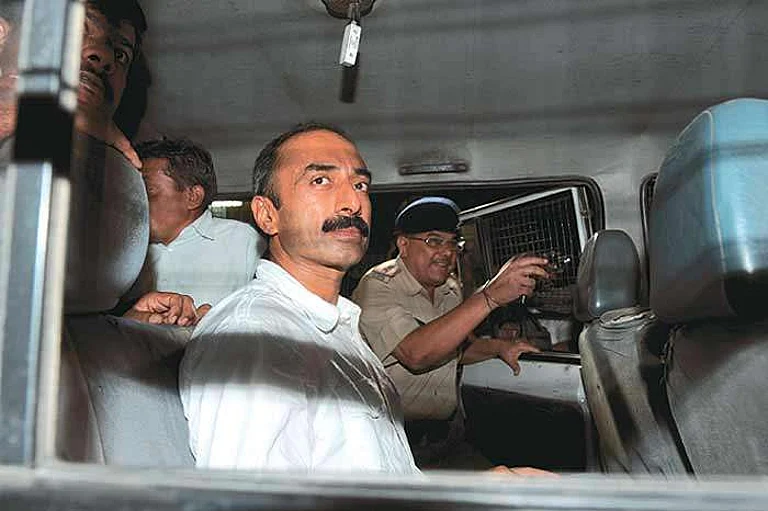A custodial death in Tamil Nadu’s Sivaganga District has sparked fresh questions about police accountability and the way custodial death cases are handled. Ajith Kumar, 27, worked as a security guard at the Madapuram Kaliamman Temple near Madurai, which is managed by the Hindu Religious & Charitable Endowments Department (HR&CE). On June 28, he was taken in for questioning by the Thirupuvanam Police based on a complaint of theft filed by a temple devotee. A video has gone viral, showing him being beaten with a lathi in a secluded spot by police personnel.
India’s Custodial Death Toll: Ajith Kumar’s Case Highlights Over 4,200 Fatalities from 2020 to 2022
The Demise Of Ajith Kumar In Tamil Nadu Has Once Again Opened the Pandora’s Box on Custodial Deaths
The following day, Kumar was declared dead. His family alleges that he was tortured while in police custody, and the post-mortem report recorded 18 injuries to his body. Based on the findings and the video, five policemen were arrested, and six others were suspended. The case has been transferred to the Central Bureau of Investigation (CBI) and a judicial inquiry has also been ordered.
Kumar’s death is not the first time such a case has come to light. Custodial deaths have been reported from several states, and in many instances, questions are raised about how suspects are treated during interrogation. Official data from the Ministry of Home Affairs, dated March 22, 2022, shows that a total of 4,247 custodial deaths were reported in India between April 2020 and February 2022. This includes 255 deaths in police custody and 3,992 in judicial custody.
In the 2021-22 alone, 155 people died in police custody across the country―Tamil Nadu reported four deaths in police custody and 93 in judicial custody. The National Human Rights Commission (NHRC), which receives these reports, has the authority to recommend compensation and disciplinary action if any negligence or wrongdoing is found.
In Kumar’s case, the police initially claimed that he had collapsed while being questioned, but the video and post-mortem report have raised doubts about the police’s version.
A study released this year by the Common Cause Lokniti Programme, titled Status of Policing in India Report (SPIR) 2025: Police Torture and (Un)Accountability, has highlighted certain behaviour within the police force that may explain why these cases keep happening. The report is based on a survey of 8,276 police personnel across 17 states and Union territories. It found that many respondents felt the use of force was part of routine police work.
Around 30 per cent of police personnel said that using third-degree methods is justified in serious cases. Nine per cent said it was acceptable even for petty offences. Some also said that slapping uncooperative witnesses or hitting family members of an accused was sometimes justified. The study found that officers, who regularly carry out interrogations, were more likely to justify such methods.
The report also looked at how legal procedures are followed during arrests. Forty-one per cent of police personnel said that procedures are always followed, whereas 24 per cent said they are rarely or never followed. Just over half of the respondents said that it is always possible to produce an arrested person before a magistrate within 24 hours. These are basic legal requirements, but the report shows that their implementation is not uniform.
According to the SPIR report, there are discrepancies in how custodial deaths are reported by official and independent sources. For instance, in 2020, the National Crime Records Bureau (NCRB) reported 76 custodial deaths; the NHRC reported 90, while the National Campaign Against Torture (NCAT), a civil society group, documented 111 deaths.
In Kumar’s case, the time between his detention and death was less than two days. According to the SPIR 2025, most police custody deaths take place in the first 24 hours of arrest. In 2022, 55 per cent of such deaths, reported by the NCRB, were of people not yet remanded to judicial custody. In Gujarat, between 2018 and 2022, 96 per cent of police custody deaths happened in the first 24 hours.
The NHRC requires a judicial inquiry in every case of custodial death. But as per SPIR 2025, in 2022, only 35 per cent of such cases led to inquiries. Between 2018 and 2022, legal cases were registered in just 10 per cent of police custody deaths. Among those, chargesheets were filed only in 12 per cent. Convictions remained at zero.
Kumar’s case shares similarities with past incidents―a person is detained; there are allegations of torture; and, then a custodial death is reported. Sometimes there is video evidence, as in this case, which adds pressure for action. But without such documentation, many cases do not reach the same level of attention. Kumar’s death is being investigated because a video was recorded. In many other cases, without such evidence, the families struggle to prove what actually happened.
Tamil Nadu has seen other custodial deaths in recent years. In 2020, the deaths of P. Jayaraj and J. Bennix in Sathankulam gained national attention. That case also involved allegations of custodial torture and was eventually transferred to the CBI. The trial in that case is ongoing.
In Kumar’s case, his family has said they want the investigation to be fair. They have also said that Kumar had no criminal background. At the moment, the outcome of the CBI probe is awaited.
According to the NHRC records, compensation was recommended in 137 cases of custodial deaths in 2021-22. In Tamil Nadu, compensation was suggested in three cases, which amounted up to Rs 8 lakh. But when it comes to follow-up action beyond compensation, the numbers are lower. In 2021-22, only one case from Tamil Nadu saw a recommendation for disciplinary action. There were no prosecutions. Nationally, there were no convictions in custodial death cases during that period.
While compensation may be offered and some officers may face suspension or arrest, the data shows that long-term accountability remains limited.


